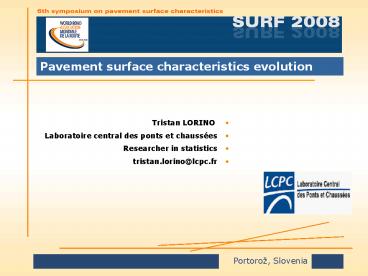Pavement surface characteristics evolution - PowerPoint PPT Presentation
1 / 22
Title:
Pavement surface characteristics evolution
Description:
Cooperation between LCPC and 'Autoroutes du Sud de la France' (ASF) ... CTF evaluated by Scrim on 43,200 sections (around 92,000 data) ... – PowerPoint PPT presentation
Number of Views:475
Avg rating:3.0/5.0
Title: Pavement surface characteristics evolution
1
Pavement surface characteristics evolution
- Tristan LORINO
- Laboratoire central des ponts et chaussées
- Researcher in statistics
- tristan.lorino_at_lcpc.fr
2
Context
- Cooperation between LCPC and Autoroutes du Sud
de la France (ASF) - LCPC French national organization for applied
research and development in civil engineering - ASF private organization operating the leading
motorway network in France - (around 2,700 km of toll motorway)
3
Context (Ctd)
- LCPC modeling the evolution of pavement
performance indicators (for structure or surface
conditions) - ASF optimizing maintenance management system by
use of predictive pavement performance models - LCPC carries out statistical analysis of the
(large and well-informed) database ArgusBase
managed by ASF through periodical monitoring
campaigns
4
Available data
- Focus on 2 major skid resistance (SR) indicators
evaluated on 100-metres long sections of slow
lanes - Macrotexture
- capacity of the road to avoid the presence of
any bulk water within the tire/pavement contact
area - sand patch texture depth (SPTD)
- Microtexture
- capacity of the road to avoid the presence of
any residual film of water within the
tire/pavement contact area - coefficient of transverse friction (CTF)
5
Available data (Ctd)
- SPTD measured by Rugolaser
- on 36,500 sections (around 78,000 data)
- CTF evaluated by Scrim
- on 43,200 sections (around 92,000 data)
- sections with different types of wearing
course - 62 are semicoarse asphalt concrete (SAC)
- 33 are very thin asphalt concrete (VTAC)
- 5 are porous asphalt concrete (PAC)
6
Descriptive analysis of SPTD data
7
Descriptive analysis of CTF data
8
Grading composition
9
ANOVA and multiple comparisons
- Statistical procedure
- Analysis of variance (ANOVA) for the overall
difference - If significance, multiple comparisons for
individual differences - Difference between wearing course types
- SPTD VTAC gt SAC
- CTF SAC gt VTAC gt PAC
- Difference between grading compostions
- SPTD coarse designs (0/14) gt fine designs
(0/10) - CTF fine designs gt coarse designs
- Critical size of the 0/6 sample
10
Statistical model for SR evolution
- Dependent variable time to reach a given
threshold of SPTD/CTF - given thresholds 90, 80, 70, , 20, 10
- Independent variables
- wearing course type
- grading composition
- Link function regression model with underlying
Weibull density of probability
11
Statistical model for SR evolution (Ctd)
- Censoring mechanism if time to reach threshold
is not an inspection time - Left censoring, right censoring, interval
censoring - Estimations of the two Weibull distribution
parameters - Estimations of the regression coefficients
associated to the independent variables
12
Statistical model for SR evolution (Ctd)
- Hypothesis tests of significant effect of the
independant variables - Goodness-of-fit analysis
- Predictions on the long term (evolution curve)
- Individualization of evolution curve for each
road section - (observations per section ? corrective
coefficient)
13
Definition of robustness
- Corrective coefficient is referred as robustness
of a section road (mechanical, not statistical
meaning) - Robustness is defined for a class of pavement
sections sharing all the same characteristics - (i.e. same values of independent variables)
- Robustness is defined as the percentage of
sections with less favourable evolution of
SPTD/CTF - Robustness is constant over time
14
Illustration of robustness
15
Illustration of robustness (Ctd)
16
Results
- Significant difference between wearing course
types concerning the evolution of SPTD/CTF - Doubtful significant difference between grading
compositions - (only for a minority of thresholds)
- Goodness-of-fit (residuals analysis) assessed
17
SPTD evolution
18
CTF evolution
19
Illustration of observed vs fitted values
20
Conclusions
- Significant impact of wearing course types on
the evolution of both indicators - SPTD VTAC have higher values than SAC
- CTF higher values for SAC, lowest for PAC
and VTAC in between - Doubtful significant statistical effect of the
grading characteristics (unbalanced samples) - Fitted curves in strong agreement with observed
values, allowing for predictions on the long term
21
Perspectives
- Include traffic as potential factor of the
evolution of SR - cumulated traffic as independent variable?
- time-related independent variable
- cumulated traffic as dependent variable?
- leads to very similar evolution curves
- class of (design) traffic as independent
variable - Need to complete the database for grading 0/6
22
Perspectives
- Thank you































